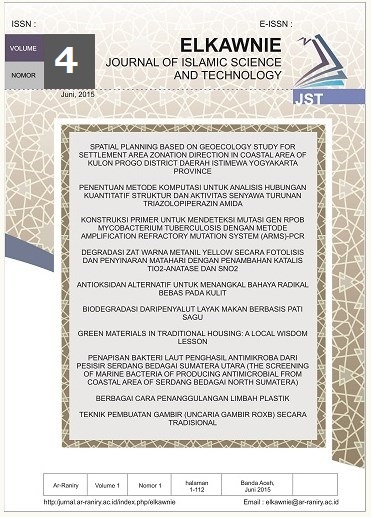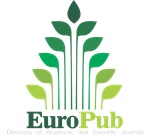Peran Teknologi Digital dalam Perkembangan Dunia Perancangan Arsitektur
DOI:
https://doi.org/10.22373/ekw.v4i1.2959Abstract
Di era yang modern ini teknologi digital telah memasuki berbagai aspek kehidupan. Hal ini dipengaruhi oleh perkembangan ilmu pengetahuan yang diiringi dengan perkembangan teknologi digital yang begitu pesat selama beberapa dekade terakhir. Dunia perancangan arsitektur baik itu di bidang profesional maupun di bidang pendidikan arsitektur tidak luput dari pengaruh teknologi digital. Teknologi digital telah menggeser metode tradisional dalam dunia desain arsitektur walaupun pada faktanya masih ada beberapa arsitek atau desainer yang menggunakan metode tradisional. Hal ini disebabkan dengan menggunakan teknologi digital proses perancangan arsitektur menjadi lebih efisien dan mudah. Disamping itu dengan menggunakan teknologi digital dalam proses desain arsitektur juga memungkinkan arsitek atau desainer untuk bereksplorasi terhadap bentuk-bentuk geometri yang tingkat kompleksitasnya lebih tinggi. Hal ini dimungkinkan karena dengan perkembangan teknologi digital yang begitu pesat, komputer tidak hanya digunakan sebagai media untuk menghasilkan produk gambar atau mempercepat proses desain saja (komputerisasi) , akan tetapi komputer sudah berperan aktif dan dijadikan bagian dalam proses perancangan arsitektur (komputasi). Dengan demikian arsitek ataupun desainer dengan bantuan teknologi digital mampu menciptakan inovasi - inovasi baru dalam dunia perancangan arsitektur. Kata Kunci : Teknologi digital, perancangan arsitektur, komputasi dalam arsitekturReferences
Agkathidis, Asterios., Computational Architecture ; digital
designing tools and manufacturing techniques, Beirut,
Autodesk 2009., Autodesk Ecotect Analysis 2010 Questions and
Answer, Autodesk, Inc., 2009
Kalay, Yehuda E., Architecture’s New Media : Principles, Theories,
and Methods of Computer Aided Design, The MIT Press,
Kalay, Yehuda E., The Impact of Information Technology on Design
Methods, Products and Practices, Design Studies Vol 27
No.3, 357-380, University of California, Berkeley, 2006.
Kotnik, Toni, Digital Architectural Design as Exploration
of Computable Functions, International Journal of
Architectural Computing, issue 01, volume 08, Swiss
Federal Institute of Technology.
Laurens, Joyce M., Imaji dan Peran Media Desain Dalam Proses
Desain Arsitektur, Jurnal Dimensi Teknik Arsitektur Vol.
, No. 1, Universitas Kristen Petra, 2003.
Mintorogo, Danny S., Arsitektur DVD (Digital Virtual Design),
Jurnal Dimensi Teknik Arsitektur, Vol. 28, No. 1, Universitas
Kristen Petra, 2000.
Nicos, Bilalis., Computer Aided Design CAD, Report Produce for
the EC Funded Project, Technical University of Crete, 2000.
Oxman, Rivka., (2007), Digital architecture as a challenge for
design pedagogy : theory, knowledge, models and medium,
Faculty of Architecture and Town Planning, Technion,
Institute of Technology, Israel, 2007.
Putra, Putu SU., Implementasi Teknologi dan Informasi Dalam
Bidang Desain Interior dan Arsitektur di Era Globalisas,
ISI, Denpasar, 2013.
Amber P., Autodesk announces Ecotect Analysis 2010 and Free Guide to Sustainable Design. Arrchdaily.com. 1 Mei 2009.
https://www.archdaily.com/21168/autodesk-announces-ecotect-
analysis-2010-and-free-guide-to-sustainable-design
(diakses 10/04/2018, 18.06 WIB)
Hermawan, Dani., Peranan dan Penggunaan Teknologi Digital
dalam Proses Desain Arsitektur. Ikatan Arsitek Indonesia
Jawa Barat. http://www.iaijabar.org/ruang-publikasi/1237teknologi-digital-disain-arsitektur.html
(diakses10/04/2018,18.06 WIB)
Downloads
Published
Issue
Section
License
Proposed Policy for Journals That Offer Open Access Authors who publish with the Elkawnie journal agree to the following terms:
a. Authors retain copyright and grant the journal right of first publication with the work simultaneously licensed under a Creative Commons Attribution License that allows others to share the work with an acknowledgement of the work's authorship and initial publication in this journal.
b. Authors are able to enter into separate, additional contractual arrangements for the non-exclusive distribution of the journal's published version of the work (e.g., post it to an institutional repository or publish it in a book), with an acknowledgement of its initial publication in this journal.
c. Authors are permitted and encouraged to post their work online (e.g., in institutional repositories or on their website) prior to and during the submission process, as it can lead to productive exchanges, as well as earlier and greater citation of published work (see The Effect of Open Access).

























